Nest Protect: New Product Review
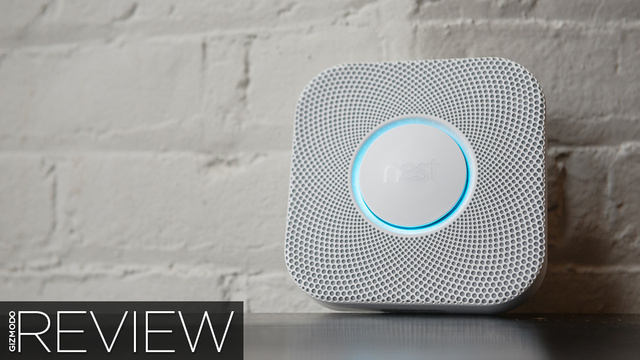
Fire and carbon monoxide detector plays an important role in your life. You don’t hear it often, but if you do, it is usually either annoying or horrifying. Protect your life with the new detector from Nest . A decidedly more “talkative” device that not only provides security, but makes you feel it. This is much more important than you think.
What is it?
Nest Protect is a device for determining the smoke and carbon monoxide in the room and then turning on the sound of the alarm. He communicates with you through verbal warnings, signals, LED lights, and also through text messages. Includes a photoelectric smoke sensor, a carbon monoxide sensor, a speaker and four sensors that detect movement, light and heat, which means that it is smart enough to know when you are in a room or if you have turned off the lights.
At the moment, the cost of such an alarm is $ 130. There is an option with a 120V power supply and battery. It is possible to easily connect to your home Wi-Fi network and synchronize the work of Nest with iOS iPhone, iPad or Android.
')
Why Need Nest Protect?
Nest is the vanguard of a new generation of products that use cheaper sensors to collect data around us.
It’s easy to buy and it’s easy enough to establish what will become a really important advantage and make it the first smart home device for millions of consumers who can still see it on the Internet as the fruit of John Spike’s imagination.
Nest points out its main goal to redesign home appliances, which collects and analyzes data about your home. It all started with a thermostat, but now it’s about home security. Last Tuesday, Google acquired Nest for three billion dollars. Both companies share two missions: Google collects information and implements projects about Internet life, and Nest does everything for family life.
Design
Nest Protect inherited the appearance of Apple, and this is not surprising, given the fact that its creator, Tony Fadell, was a design consultant on the first iPod. Its size is about 13 by 13 cm. It is black and white. On the bottom side, a ring of five colored LEDs changes shades depending on the alert — green means “OK, everything is normal,” blue means testing, yellow indicates a low battery, and red means alarm. There is also a white color for night lighting.
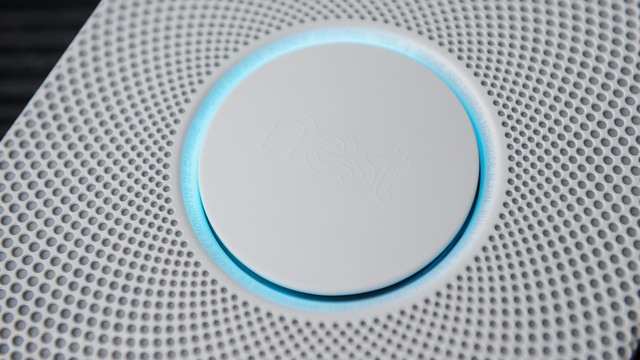
This is with regard to product design. What about UI and UX? This is where Nest literally glows. So far, no project team has made a truly intuitive gestures system, and Nest did just that. Even the least experienced user will be able to master the simple commands of Nest Protect: wave your hand to silence the warning. Press the button to test the device.
Using Nest Protect
When I moved to our ancient two-room apartment near the railway last year, the landlord provided a dirty and battered “fire alarm” that was plugged into the electrical grid in our bedroom. His LCD screen did not turn on and we still did not hear how he was picking. In the end, we turned it off. Now, I know what the reader will think: You are stupid! Have you lived for several months without a fire alarm?
So, the Nest Protect review can be done because of its simplicity. Unpainted carton packs were a huge relief to me. And the installation was more than encouraging. As soon as you take it out of the box and pull the tab from the battery (there is also a 120V wired version), its LED ring delivers several blue pulses. The alarm represents itself in a calm female voice. You make a choice of language - either Spanish or English automatically, but you can download French and British English by pressing the button, the device makes a quick test:
After I downloaded the Nest iOS app, I set up a connection to my Wi-Fi network. This turned out to be surprisingly simple. First of all, you specify the QR code, which is located on the back cover of Nest Protect:
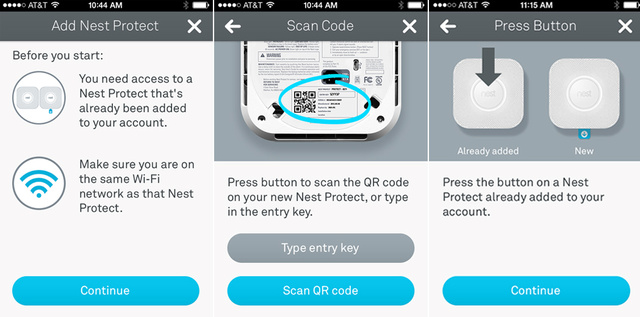
This creates a network name in your Wi-Fi network, which you will find in the Wi-Fi settings of your phone. Your phone and alarm will take about three minutes to sync, and then Nest Protect will flash green and indicate that sync is complete. From this point on, you can click on the signal icon on the device and Nest will inform you about everything happening in real time, and also alert you in an emergency:
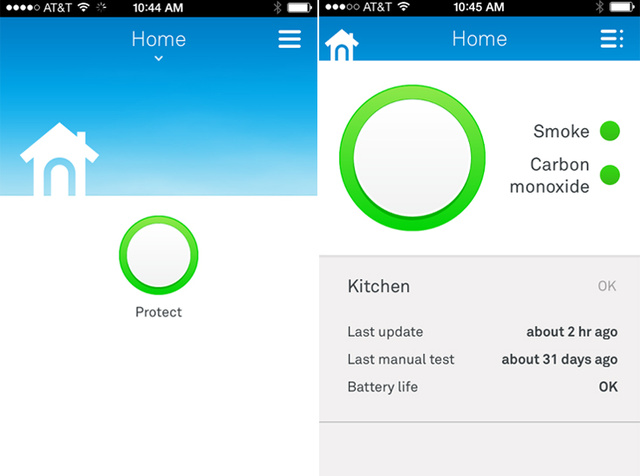
When I sat at the table to set up an alarm, I thought I would spend at least half an hour. But it took me 3 minutes. All that is left to do is to install it on the wall or ceiling with a small plastic plate and four screws.
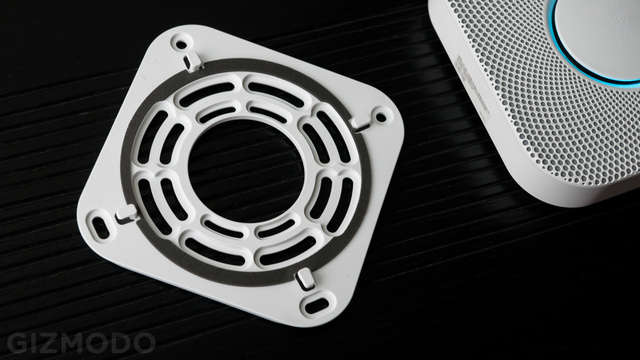
Every night, when we turn off our light to go to sleep, the LED ring sends green pulses for three seconds, as if to say that "everything is in order, I work." And when one of us gets up in the middle of the night to drink or go to the bathroom, the ring emits white light, illuminating our apartment just enough to not trip over the bicycle pedals or table legs.
These are not killer functions. The real virtue of Protect lies in its warning system, of course. Every second fire alarm I used was designed with the following alerts: this is either a beep or nothing. Nest absorbed the experience of other alarms and turned a device that can always be understood on an intuitive level.
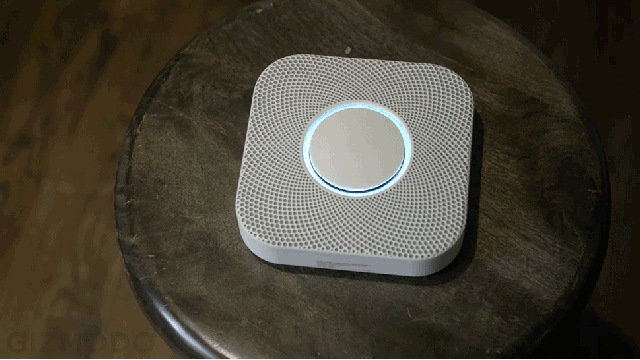
However, writing a review about a fire alarm without testing it would not be very helpful. Therefore, we used a can of synthetic smoke, putting it next to Nest Protect. When Protect detected our fake smoke, it pulsed with yellow and gave us a verbal warning: Emergency. There is a smoke in the bedroom. The alarm is sounding. . Then (very loudly!) The beep sounded.
We fell silent, and when the smoke cleared, Protect glowed green and let us know that we needed to clear the room. Everything is good. If you have installed several units, it transmits this message to all of them, indicating exactly which smoke was detected.
Like
The incredible experience of UX and the engineering know-how that went into Protect make it unique in its kind. To set up the device does not take more than three minutes, and the methods of interaction with it are intuitive. This is a tribute to Fadell and his team, who took the device associated with a very unfavorable topic, and turned it into something that will allow home appliances to a new level.
No like
The US government recommends installing a fire alarm "in each bedroom and above the stairwells," which makes the cost of Nest Protect closer to $ 1,000, (you will agree a lot) if you live in a big house. Another cause for concern is the fact that the USFA recommends replacing fire alarms every seven years, which is also quite expensive.
Nest's decision to make a fire alarm that costs three times as much as competitors in the market is a bit rash, however. Young people who live in studios or one-bedroom apartments and have a desire to use high-tech devices may well spend $ 129 to protect themselves from fire. Another thing, if it concerns people who live in large houses.
If You Bought Nest Protect?
For most readers, I think the question comes down to cost. If you live in a small apartment and need to buy a couple of such devices, I would sincerely recommend it to you. It can serve just like other fire alarms - it can wake you up when something caught fire, but this device has a significant plus: It makes you feel safe.
Source: https://habr.com/ru/post/209854/
All Articles